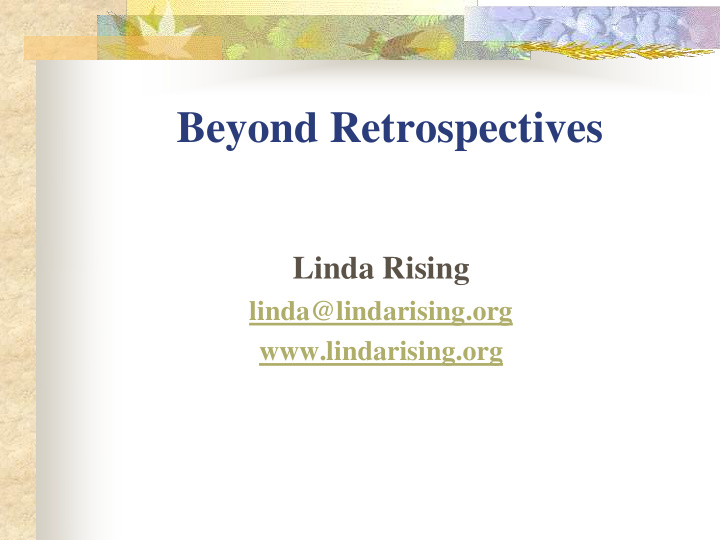



Beyond Retrospectives Linda Rising linda@lindarising.org www.lindarising.org
Call for insights ! A new article series in IEEE Software Stories, case studies, experiences More informal review process Shepherds available for writing Send ideas to: linda@lindarising.org
At regular intervals, the team reflects on how to become more effective, then tunes and adjusts its behavior accordingly. agilemanifesto.org/principles.html
Project Retrospectives A retrospective is an opportunity for the participants to learn how to improve. The focus is on learning — not fault-finding. Norm Kerth
Agile Retrospectives How to mine the experience of your software development team continually throughout the life of the project.
Reflect and find a better way Here is Edward Bear, coming downstairs now, bump, bump, bump, bump, on the back of his head, behind Christopher Robin. It is, as far as he knows, the only way of coming downstairs, but sometimes he feels that there is another way, if only he could stop bumping for a moment and think of it. A. A. Milne Winnie the Pooh
Is that a postmortem?
A little retro history Postmortems or project reviews Retrospectives Iteration retrospectives Real-time timelines continuously capture ideas for experiments and retrospectives are about those experiments “We used to rely on retrospectives - now we focus on continuous feedback.”
Agile vs. End of Project On an agile project, each iteration should involve a few small experiments The retrospective questions should focus on the experiments, e.g. “What worked well about moving the time of our stand- up?” Agile retrospectives are about getting ready for the next iteration, not about solving all the problems the team has. You may not be able to solve a given problem, but you can always set up a small experiment. Project retrospectives take more time and identify best practices to share across the organization.
The Old Timeline
The New Timeline Real-time provides instant feedback and possibility for course correction Add a different color for experiments Anyone, at any time, can suggest an experiment for the next iteration Shifts from problem-identifying/solving to more exciting/interesting experimenting
The driving questions are the same What worked well that we don’t want to forget? What should we do differently? What did we learn? What still puzzles us?
The Prime Directive is still used Regardless of what we discover, we understand and truly believe that everyone did the best job they could, given what they knew at the time, their skills and abilities, the resources available, and the situation at hand.
Beyond exercises and activities More movement and singing More writing and drawing More food More natural surroundings More diversity More pets
What do cognitive scientists tell us? The areas of the brain involved in (prospect) thinking about the future – insight – occurs during idle time – are the same areas of the brain involved in thinking about what others are thinking. Right temporoparietal junction RTPJ, one of the areas that’s most different in our brains. It takes a long time to develop ~age 5. We need to take time off, let the mind wander, listen to others, take another point of view.
Move!
Write, Draw, Sketch Typing is the least effective means for description Writing by hand is useful for solving problems of all kinds Drawing, sketching are also helpful – research shows that doodlers remember more information than note-takers – encourage doodling at all meetings!
Doodle.com – the Doodle Revolution
Drink, Eat Even mild dehydration affects the brain – always have water on hand – watch the caffeine Decision-making requires energy, if tired and hungry people are forced to make decisions, they look for the easy way out – study of judges granting more favorable verdict after breaks
Cutting edge More natural surroundings, windows, real plants or flowers Pictures or screens not as effective People are more creative, generous, community minded
Diversity! Have more women on the team or involved somehow. Preliminary research shows higher quality collaboration, changes the behavior of the male members, increases group intelligence and overall performance. http://hbr.org/2011/06/defend-your-research- what-makes-a-team-smarter-more-women/
Animals! Research shows dogs in the workplace result in better collaboration within teams.
Menlo Innovations menloinnovations.com/ Software design and development should be a joyful experience. To achieve this joy, we have changed everything.
Try your own experiments From Fearless Change : Test the waters – try some small innovation Time for Reflection – stop, ask how it worked for you Small Success – learn from what worked Step by Step – use your successes to determine the next small experiment
Next Steps Check out menloinnovations.com Buy and read Norm Kerth’s book: Project Retrospectives , Dorset House, 2001 Buy and read Esther Derby and Diana Larsen's book: Agile Retrospectives , The Pragmatic Bookshelf, 2006 Check out Linda’s web site – click on Articles, then Retrospectives Sign up for the Yahoo group: retrospectives
Retrospectives a closing thought from Norm Kerth (and Edward Bear) … we bump our heads in project after project, day after day. If we would only take a moment to stop and think of alternative ways to proceed, I’m sure we could find better ways to do our work. Norm Kerth
Recommend
More recommend